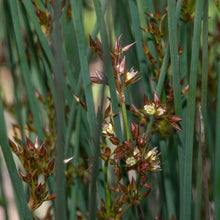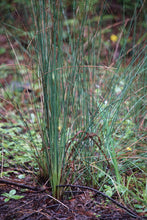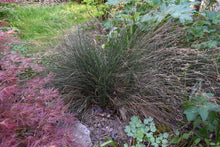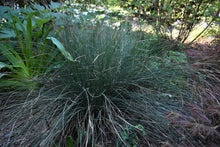
Juncus patens
Spreading rush, aka spreading blue rush or Paten’s rush, is easily recognizable by the lovely bluish hue of its evergreen, architectural foliage. In the plant world, we call this tone "glaucus" (now isn't that a great word?!) Botany nerdom aside, this plant really pops in the habitat garden. In summer, small golden flower clusters that bloom along the stems before maturing into bunches of spherical red fruits that attract and provide a valuable food source to neighborhood songbirds. While its unique evergreen foliage adds year-round visual interest, erosion control services and insectary habitat to sunny areas with ample moisture, such as a raingarden or bioswale.
- Plant type/canopy layer: evergreen, perennial, herbaceous plant
- Size at maturity: 12-24" tall; 12-36" wide
- Light requirements: full sun, part sun/part shade
- Moisture requirements: moist to wet soil
- Bloom time: June - July
- Growth rate/ease: grows quickly, very easy to grow
- Wildlife support: seeds provide food for birds; overall plant attracts and supports beneficial and other pest eating insects, particularly by providing year-round refuge, and acts as a caterpillar host plant and larval food source for native butterflies and moths
- Native habitat/range: Common along shores, and in floodplains, wet prairies, wet forests, swales, marshes, and ditches up to 1000 meters from western Washington, through western Oregon and south to Mexico. Portland Plant List - yes.
- Special features & uses: raingarden/bioswale, evergreen, erosion control
Gardening with Spreading Blue Rush: This plant is truly a joy to design with. Although it is normally found in areas that are moist year-round, it is tough and can tollerate seasonal drought. Try it in full to mostly sunny areas near or in water features, such as a raingarden or bioswale where it will provide beauty, strong architechtural interest and habitat function. This plant is becoming increasingly common in mainstream landscape design - especially in cities like Portland where local agencies often require native plants in new development. This is great because it also has lots of ecological value from controlling erosion to providing insect/arthropod habitat.
That said, unfortunately it is also common to see this (and many) native plants maintained in aggressive, “blow-and-go” fashion that strips them of their ecological benefits; like cutting back all of the vegetation on the rushes at the end of the growing season. If you intend to build a backyard habitat, start with maintaining your plants in a low-impact way that supports insects (aka, leave them be). One of the greatest habitat values of native grasses, sedges and rushes is the insect/arthropod nesting habitat created in the areas where the foliage flops over onto the ground. Trimming this off diminishes the ecological value and can even create ecological sinks by interrupting their life cycles and destroying overwintering nests, larva, eggs, etc.
Photo Credit 1 (inflorescence close-up): © Don Loarie, some rights reserved (CC-BY)
Photo Credit 2 (new growth): © Karen and Mike, some rights reserved (CC-BY)
Photo Credit 3 & 4: Nikkie West, Sparrowhawk Native Plants







